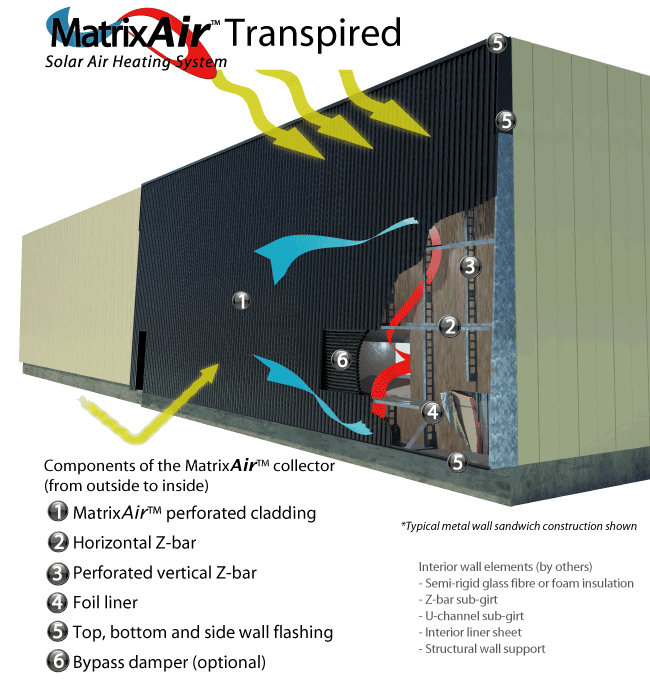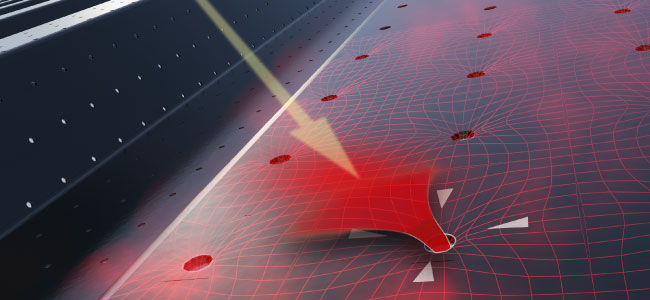Solar Air Heating System and Ventilation Air Heating

How the MatrixAir™ Transpired solar air heating system works
The MatrixAir™ building-integrated solar air heating system is designed for cold climates, our transpired exterior metal cladding is installed on a building's outer south, east or west wall, or on roof mounted modules. During the day, as outside air passes through the perforated solar air cladding the sunlight striking the cladding is transferred into usable heat that is drawn into the building's HVAC system. At night, this perforated solar air heating wall becomes a huge heat recovery unit as the heat loss passing from the inside of the building to the outside is picked up by the incoming air and brought back into the building.
Resembling conventional metal siding, transpired solar air heating systems are typically sized according to the building’s fresh air requirement. In general terms, each square meter of transpired solar air heating cladding is sufficient to heat between 14 and 42 l/s of air. A southerly façade measuring 1000 m2 could therefore preheat between 14,000 and 42000 l/s of incoming fresh air. The higher the air flow per unit of solar fresh air collector area the higher the system efficiency but at lower delivered air temperatures, and vice versa.
During sunny days a transpired collector will producing upwards of 700 W/m2 to preheat intake air by 17°-30°C, depending on the flow rate, over ambient temperatures. Snow will reflect up to seventy percent of solar radiation with about forty percent of this radiation reflected on the perforated cladding surface, further increasing the system's performance. MatrixAir™ TR (transpired) solar air heating systems work on cloudy days too since diffused light can represent up to twenty-five percent of the total solar radiation available on a sunny day.
MatrixAir™ TR Building-Integrated Solar Air Heating Collector : Bottom air outlet benefits
MatrixAir™ TR solar air heating is an active solar thermal system requiring a mechanical means of moving the air through the perforations, the air cavity behind the cladding and into the building. Since MatrixAir™ TR solar air collector is not a thermosyphon system the natural upward movement of heated air has little if any impact on our systems' performance in winter preheat operation.
The suggested lower air outlet feature of the MatrixAir™ Transpired Solar Air Heating system offers a number of advantages:
• Convection and radiation heat losses at the extremities of the solar air heating collector are minimized,
• A lower position of the bypass damper greatly reduces the hot air short-circuiting the system during summer operation,

• The integration of hybrid system heat exchangers or seasonal storage is greatly facilitated due to the proximity of the solar air heating collector’s outlet to such equipment,
• The combination of a lower air outlet and use of the perforated framing stimulates increased air turbulence within the solar air heating collector thereby increasing the heat gain,
• It will complement our inclined solar fresh air collector design. Even slight collector inclination increases solar gain. For example, in moderate climates the slight change in the inclination of the collector from 90°C to 88°C yields an increase of 3% in annual energy production. The deeper cavity resulting from this inclination enables a more uniform heat gain across the collector surface and creates the internal plenum required of the greater air volume moving adjacent to the outlet thus reducing the energy load of air handling equipment.
MatrixAir™ Transpired (TR) Solar Air Heating System - Patent pending.
Solar air heating for commercial, industrial, institutional and agricultural buildings available in Quebec, Ontario, Nova Scotia, Maritimes and New Brunswick.
The information contained herein is subject to change without notice.